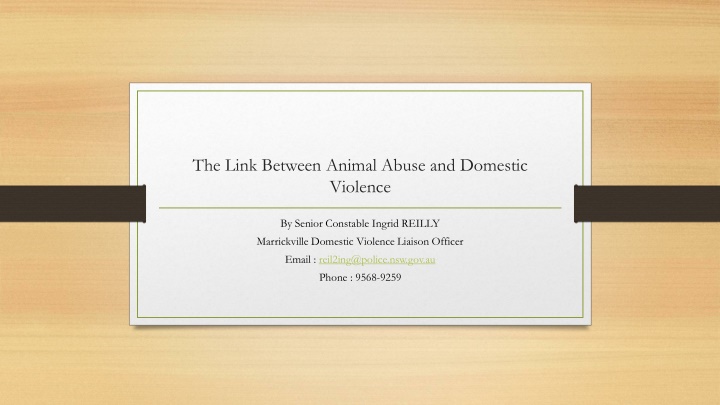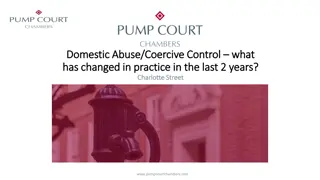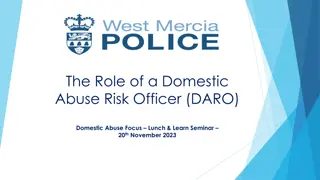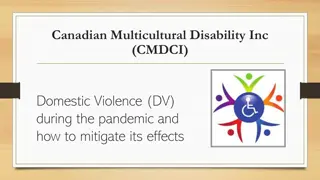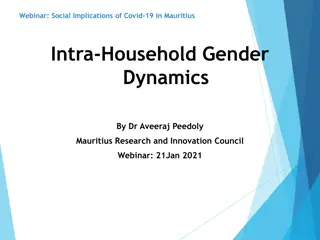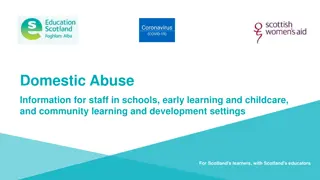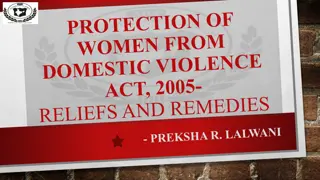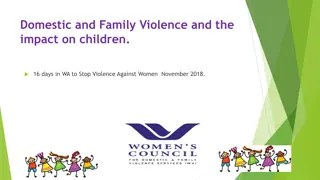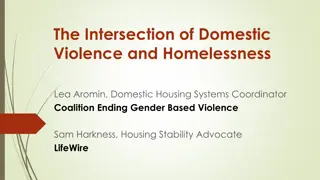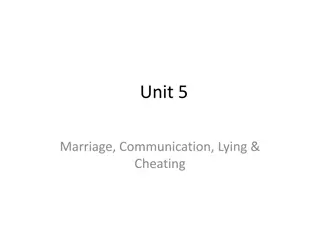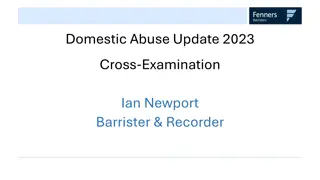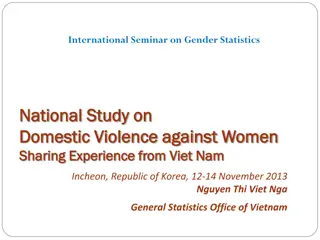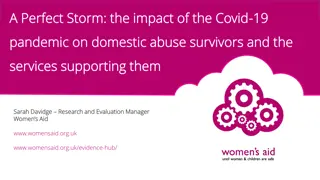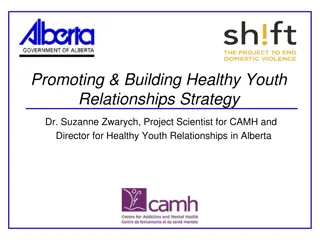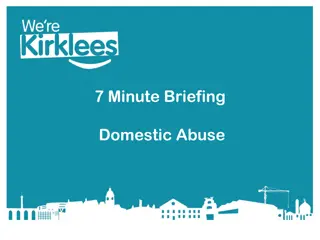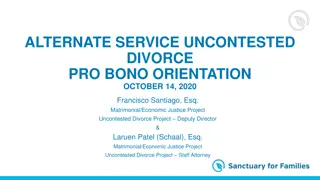The Link Between Animal Abuse and Domestic Violence: Understanding the Connection
Abuse is often cyclical and inter-generational, with animal abuse strongly linked to domestic and family violence. Perpetrators harm animals to demonstrate power, control, and enforce submission, creating an environment of fear, isolation, and vulnerability. Statistics show the significant impact of animal abuse on domestic violence situations, emphasizing the need for early intervention and support for victims who fear leaving their pets behind.
Download Presentation

Please find below an Image/Link to download the presentation.
The content on the website is provided AS IS for your information and personal use only. It may not be sold, licensed, or shared on other websites without obtaining consent from the author.If you encounter any issues during the download, it is possible that the publisher has removed the file from their server.
You are allowed to download the files provided on this website for personal or commercial use, subject to the condition that they are used lawfully. All files are the property of their respective owners.
The content on the website is provided AS IS for your information and personal use only. It may not be sold, licensed, or shared on other websites without obtaining consent from the author.
E N D
Presentation Transcript
The Link Between Animal Abuse and Domestic Violence By Senior Constable Ingrid REILLY Marrickville Domestic Violence Liaison Officer Email : reil2ing@police.nsw.gov.au Phone : 9568-9259
What is The Link ? Abuse is often cyclical and inter- generational. The earlier professionals can intervene to break the cycles of violence, the higher rates of success.
What is The Link ? Animal abuse is strongly linked with Domestic and Family Violence (DFV)
Some statistics / trends Around 70% of respondents experiencing DV reported that perpetrator was also abusing and/or neglecting pets compared to 6% in household not experiencing DV (Tong, 2015) Males are responsible for almost all (about 90%) acts of violence towards humans and pets (Arkow 2016, Tong 2015, Tiplady 2013) Approximately 60% of domestic violence victims stay in abusive situations because they don t want to leave their pet behind. Research in Nashville, USA shows that the top 3 indicators of domestic homicide are the perpetrator : -threatening suicide - Has access to weapons - Has threatened to, or has, mutilated or killed pets - 99.4% of animals who were refused access to the basics such as food and water lived in households experiencing DV (Tong, 2015)
Some statistics / trends 15% respondents delayed reporting DV to police due to fears for their animals (Tong 2015) Dog bites were 11 times more common in families experiencing violence within the home (Lockwood 1998) Dogs are the main type of animal to be abused (cats second) (Tong, 2015) Australia study when leaving with their animals, 92% were turned away from refuges, 70% from government rental, 60% from private rental and around 33% from family and friends (Tong, 2015) Children who experience abuse towards animals, or abuse within the home, are also more likely to abuse animals or perform acts of violence towards people later in life. 15% of respondents returned to violent homes due to fears for their animals (Tong, 2015)
Why do perpetrators harm animals ? (DV) To demonstrate power and control over the family To isolate the victim and children To enforce submission To perpetuate an environment of fear, vulnerability and isolation To prevent the victim from leaving or to co-erce her to return To punish the victim for leaving or for showing independence Abusers are well aware of the bond between their victims and their animals and they exploit that bond to control, manipulate, frighten and punish their victims Source : www.domesticviolenceroundtable.org
Why do perpetrators harm animals ? (general) To control an animal (ie : discipline ) To retaliate against / punish the animal To express aggression through an animal (eg training to attack) For shock value To retaliate against another person (easier than hurting the person) They get satisfaction from it (sadism) Ignorance
Spot Abuse (www.spotabuse.org) A program piloted in Milwaukee encouraging residents to dial 911 when they suspect animal abuse to uncover domestic violence cases.
What constitutes animal abuse ? Physical abuse kicking, beating, throwing against walls Emotional (such as intentionally confusing / tormenting / yelling at) Intentional neglect withholding access to food, water, vet treatment, shelter. Almost all pets who were refused access to basic necessities lived in households experiencing DV (Tong, 2015) Sexual abuse in a small number of cases.
Police Along with the RSPCA and AWL, police are considered as Inspectors under the Prevention of Cruelty to Animals Act (POCTAA) so can take legal action accordingly however, police are obviously not specialists in this field hence why are agencies work in together. We can remove animals and find emergency accommodation (local vet, pound etc) Inclusion of the question has your partner harmed or threatened to harm the family pet in our Domestic Violence Safety Action Tool (DVSAT) risk assessment checklist intimate partner relationship only. Potential for Safety Action Meetings (SAMs), Domestic Violence Evidence in Chief (DVEC), targeting DV Suspect Target Management Plans (STMP)s inadvertently helping animals too. New Plain English AVOs (and broadening of what constitutes a domestic violence offence). As pets are considered as property they are considered in the mandatory orders of an AVO, not damage (and pets are specified as an example in the orders) free form condition also available.
Police (Cont) AVO - Can exclude perpetrator from family home. Intelligence reports (including animal cruelty) can build information on a person. Strengthen AVO protection with bail conditions Police are time poor DV s labour intensive. We need services and solutions available.
Children Exposing children to animal cruelty may desensitise them against all forms of violence. Children who experience abuse within the home to people or animals, are more likely to abuse animals or perform acts of violence towards people later in life. They are also more likely to experience behavioural problems such as bullying. More than 1/3rdof respondents (42% in Tong s research) reported that children in DV households witnessed abuse to animals within the home this is obviously psychologically damaging, particularly when the child has a close bond with that animal and dangerous to the child who will often try to protect their animal. Frank Ascione (from the US) one of the most cited academics on the link between domestic violence and animal abuse. Much of his research focuses on children who grew up in houses where animal abuse occurred. Professor Mark DADDS from UNSW is doing similar research here in Australia.
Educating young people Carl Coorey-Ewings from Trinity Grammar did his final year Baccaluarette on this topic last year. He wrote a paper and did a presentation to his peers titled Animals the Silent Victims of Domestic and Family Violence . Visits to Farm Sanctuaries such as Where Pigs Fly and Peanuts Funny Farm in NSW and Edgars Mission in Vic. Thinkkind (www.thinkkind.org) free resource centre in Australia for teachers and parents who s aim is to build a more compassionate and sustainable world through humane education. RSPCA have many programs for young people and are aligned with programs such as Headspace (Matt French is a good contact).
The Elderly May not be able to care for their animals adequately, or neglecting themselves in order to care for their pets. They are at risk of being exploited by those who would take advantage of their attachment to pets. Many nursing homes don t allow pets. RSPCA s program POOPS (Pets of Older People) Sydney Uni Vets community program where new vet student s walk elderly people s pets in need.
How can you help ? We (WDVCAS etc) can help make referrals to Victim s Services to help with costs of boarding animals. When the DVSAT Q s are asked again when considering Q5 (re harm to pets) be mindful that many people feel more comfortable with services other than police. Do not down play the crucial importance of an animal to some domestic violence survivors. Assist with inclusion of pets on property recovery orders. Remember that your intervention about this issue (and provision of available resources) could be the difference between a woman leaving or staying in her relationship.
How Can you help etc ? Applications via Victim Services for cameras at home. Ensure that victim obtain counselling many feel overwhelming guilt about not being able to protect their animals. Help with safety planning for pets. Put the work in there is a definite gap in the system so it will often take perseverance and time.
The human / animal bond Pets are often treasured sources of emotional support, unconditional love and stability for abused partners and children. But this bond is often exploited by abusers in fact, perpetrators will often target a particular animal who their partner / child is most attached to.
What organisations / programs are available in NSW ? RSPCA s Safe Beds for Pets (and foster carers). RSPCA are very aware of the DV/animal abuse link every animal has a human story Refuges accepting pets : Jewish House - Bondi, Roar (Families) and Jessie Street (for single females). Roar is run by DVSM who have great info about the link on their website (www.dvnswsm.org.au) Southern Cross Vets : Project Hope Paws and Recover Pets In the Park and Living Ruff for people experiencing homelessness. Team Dog charity which works to assist pet owning families in times of crisis.
Other organisations Australia wide Lucy s Project (www.lucysproject.com). Join us on facebook. My Saving Grace (www.mysavinggrace.org.au) Pets In Peril part of the Eastern Domestic Violence Service (EDVOS) in Melbourne. The Love, Hope and Gratitude Foundation in SA founded by DV survivor Glyn Scott Animals Defenders Office working with CLC s in NSW and ACT Patricia Giles Centre in WA fostering program Pets In Crisis in QLD, affiliated with DV Connect. Foster care network Safe Pets, Safe Families Keeping People and Their Pets Together in SA.
And Internationally The Link Coaltion (www.nationallinkcoalition.org). (working together to stop violence against people and animals) Incredible resource from the US. National Law Enforcement Centre for Animal Abuse US The Links Group, UK (www.thelinksgroup.org.uk) multi agency group that promotes the welfare and safety of vulnerable children, animals and adults so they are free from violence and abuse. SAF-T (Sheltering Animals and Families together) fantastic, practical resource about setting up animal friendly refuges. Founded by Allie Phillips former Prosecuting Attorney from Michigan
Recording & Sharing animal abuse incidents. 1.1.2016, the FBI started collating and collecting figures about animal abuse due to its indicator of violent offences, including domestic violence. Animal abuse in the USA is now classed as a felony for the same reason. There is currently no animal abuse register in Australia but there should be !
Safety Planning for PINOPs with Pets Micro-chipping do not change to new address (find alternative) Gather together vet paperwork, medication, registration forms etc Find them a safe place ahead of time, one that the perpetrator will not seek out.
Use your influence Create change from within in an organisation which may need further education / awareness raising about this topic. Raise topic at any meetings you are part of to see what you can collectively do. Do you know of grants available for a program which may assist (such as a fostering program) consider fostering yourself ! Submissions ?
Why should we care about animals in a DV context ? Many victims will not go forward with the prosecution of their abuser but animal cruelty charges may mean that the perpetrator receives some form of penalty or intervention which may assist. Neighbours are more likely to report suspected animal abuse/neglect than child welfare, DV or elder abuse, making the organisation taking report (RSPCA etc), the first responder for a family in crisis. Animals are voiceless and (like children and the elderly) vulnerable and rely on us. Interest in animal law is increasing world wide dedicated courts in the US, animal police in New York and the Netherlands.
The potential role of vets Dr Lydia Tong 2015 research of 1300 people. Dr Freda Scott-Park in the UK chairman of The Links Group Vets can identify non accidental injuries in pets and, in some countries like the UK, have DV info on hand. In some countries (NZ, Canada and some states in the US), vets are mandatory reporters when they suspect that DV is happening in the family home. Dr Tong s study 65% of respondents wanted the vets help in reporting abuse of their pet to RSPCA or police, 76% would want help from vet to find shelter for their animals, 88% believed that vets should be legally required to report suspected animal abuse to RSPCA or police, 96% felt that vets should share animal abuse info with police /rspca.
Role of Vets (cont) In Dr Tong s study when animal is injured as a result of abuse, 13/224 abuser took animal to vet, 57/224 victims took animal to vet, 6/224 had someone else take animal to vet, 155/224 did not take animal to vet. Why not ? Afraid abuse would be reported to RSPCA / police, fear of retribution, lack of funds / transportation, feelings of shame for not having vaccinations etc up to date, fear of being judged by vet. Therefore, it is important to link up with a vet who is familiar with DV Southern Cross, St Peters.
What are the barriers ? It s hard enough getting accommodation for women let alone having to worry about their animals there are very few welfare agencies interested in the animal factor of DV as they are concentrating on the victim or the police are concentrating on the offender. Animals appear to slip through the cracks of the system. (police prosecutor) Animal cruelty offences are harder to investigate as animals cannot speak. For the same reason, they are easier to forget about Lack of available pet friendly accommodation / refuges Inadequate sentences for animal cruelty offences Lack of perpetrator programs in Juvenile Justice / Corrective Services
Barriers (continued) Animal cruelty in Australia often undetected / unreported and successful conviction rates are low. RSPCA and AWL are essentially charities and NSW Police are thinly spread. Perpetrators are aware of this and know that their animal abuse is unlikely to be discovered. Police are only one part of the judicial system everyone needs to understand this link and give it the importance it deserves. Outside of the RSPCA and AWL, not all staff of other interested agencies (police, refuge workers, magistrates, lawyers are animal people . Lack of options for offender s pets even easier to forget (no programs, question not asked when going into custody). Increased use in drugs such as Ice has reportedly led to an increase in violence towards animals as well as serious neglect forgetting to feed.
And yet more barriers Lack of pet friendly accommodation not just refuges but rental properties, department of housing etc. Animals, particularly dogs, from abusive homes sometimes do not behave well in foster families (aggression etc) The obvious danger for foster carers when a violent perpetrator is involved so carers need to be located well away from victim s location.
Rural areas Farm animals are at risk too especially considering the isolation factor in rural area. Lack of options available for women to ensure animals are being fed etc if they leave Lack of help available RSPCA too far away. Vets may not want to get too involved or go to court in small communities The running of a farm, including feeding stock, is often considered more important to some victims than their own safety.
Real Life Examples Woman sent photo of dog dangling off balcony by perpetrator as a threat to make her come home. Woman trying to leave with her dog only place she felt comfortable with her dog, a run down but very pet friendly pub was not supported by Link2home so she was not provided financial assistance. Young woman experienced DV frequently but only reported to police when partner threw her beloved cat against the wall ( I could cope with him hitting me but not my cat ) Specialist DV prosecutor advised that she comes across animal abuse (with DV) about one instance a month. A woman I worked with only left violent partner when Safe Beds For Pets referral had been made man had been abusing her dog, her child and her. Puppy and cat killed in front of children and woman prison sentence imposed recently. Sometimes abuse can be more subtle..
Room for Improvement. More programs encouraging kindness to animals / empathy building. School programs such as Love Bites and Our Watch could include subjects. Local Councils took more of an active role and could see the holistic benefit of including kindness to animals programs. More intervention programs for offenders charged with DV/animal cruelty offences as in US to reduce re-offending. Availability of more Grants to support victims of domestic violence and their pets (and refuges accepting pets). More training about the DV / Animal Abuse link for more first respondents to a household like rangers / FACs. For animal abuse cases to receive appropriate sentences at court frequently dealt with very leniently.
Further Reading Pets As Pawns (Dr Michael Roguski) NZ study from 2012 Hope Was All I Had Glyn Scott Animal Abuse : Helping Animals and People (Catherine Tiplady, 2013) Child Abuse, Domestic Violence and Animal Abuse Phil Arkow and Frank Ascione
Quotes "He who is cruel to animals becomes hard also in his dealings with men. We can judge the heart of a man by his treatment of animals." Immanuel Kant. "I am sometimes asked, 'Why do you spend so much of your time and money talking about kindness to animals when there is so much cruelty to men?' I answer: 'I am working at the roots.'" George Thorndike Angell.
2012 Rose Brooks Centre (first DV Shelter in the region to welcome dogs) https://www.youtube.com/watch?v=79JmBowTb5E
